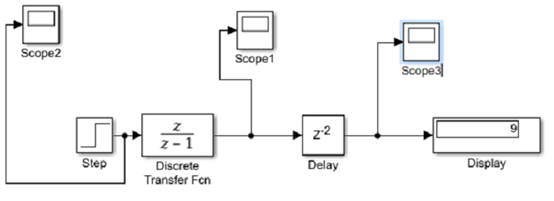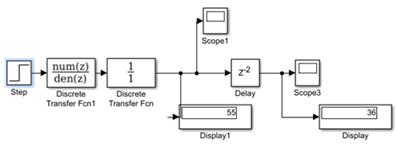This set of MATLAB Puzzles focuses on “Z Transform – 2”.
1. The unit delay operator can be thought of in the z-domain as ___________
a) Multiplication by z-1
b) Multiplication by z
c) Multiplication by z-2
d) Multiplication by z2
View Answer
Explanation: If a signal is delayed by one unit in time, the Z-transform of the resultant signal is the Z-transform of the original signal which gets multiplied by z-1. Hence, the correct option is Multiplication by z-1.
2. The convolution of a signal in time domain can be viewed as __________
a) Multiplication in z-domain
b) Squaring in z-domain
c) Doubling the signal in z-domain
d) Convolution in z-domain
View Answer
Explanation: This is observed from the fact that a signal can be represented as a summation of impulses and while we perform convolution in a time domain, we can represent the entire output in the form of z-n.
3. The impulse response of a discrete time system is the inverse Z-transform of the transfer function of the system in z-domain.
a) True
b) False
View Answer
Explanation: The Z-transform of the impulse response of discrete time system gives the transfer function of the system in z-domain. This can also be achieved from the impulse invariance transformation. Hence, the converse should be true and the above statement is true.
4. What will be seen in the scope if the step time is 1 second in the following Simulink Model?
![u[n-3] will be seen in scope if step time is 1 second in Simulink Model](https://www.sanfoundry.com/wp-content/uploads/2018/12/matlab-puzzles-q4.png)
a) A unit step signal delayed by 2 units in time
b) u[n-3]
c) A ramp function
d) An impulse function
View Answer
Explanation: Since the step time is 1, the input step signal is delayed by 1 unit already. Moreover, multiplying the signal by z-2 delays the signal further by 2 units.
5. What will be seen in the scope if the step time is 0 seconds in the following Simulink Model?

a) A unit step signal delayed by 2 units in time
b) u[n-3]
c) A ramp function
d) An impulse function
View Answer
Explanation: The delay block will delay the signal by 2 units in time.
6. What will be seen in the Scope if the step time is 0 seconds in the following Simulink Model and the limit of x axis is n=10?
![r[n-1] will be seen in the Scope if the step time is 0 seconds](https://www.sanfoundry.com/wp-content/uploads/2018/12/matlab-puzzles-q6.png)
a) A delayed ramp function
b) r[n-1]
c) r[n-2]
d) Error
View Answer
Explanation: The output of the transfer function has a the function r[n+1] and it gets delayed by two units in time to become r[n-1]. This is why the Display of the model shows 9 at n=10.
7. How much does the delay change, if the step time is taken as two units in time, in r(t-m), in scope 1 and 3?

a) 1 and 3
b) 2 and 3
c) 3 and 1
d) Error
View Answer
Explanation: In scope 1, the input of the Transfer function block is u(t-2) and the step response leads to multiplication in z-domain which shows that the ramp output gets advanced by 1 unit and the result of scope1 is r(t-1). After going through Delay of z-2, the output is r(t-3).
8. This is the output of scope1.

What is the transfer function1?
a) z/(z-1)2
b) z2/(z-1)2
c) A parabola
d) A impulse function
View Answer
Explanation: Since the output of scope 1 is a parabola and it has come from a system where the step response is seen at the output. Now, the step response is the convolution of a step signal with the impulse response of the system. In z domain, the step response becomes the product of the z-domain step signal and the transfer function of the system in z domain. Hence, it should be a ramp function whose transfer function is given by a. Option z2/(z-1)2 cannot be the answer since the graph shows the output delayed by 1 unit in time while option z2/(z-1)2 would’ve made the graph advance by 2 units in time.
9. The Discrete Transfer Fcn1 is using a ramp function.

a) True
b) False
View Answer
Explanation: The three delays received by the output of the transfer function suggests that the response of the transfer function is a parabola itself. Thus the above statement is necessary for this case.
10. What will be seen in the scope?

a) A ramp function
b) A step function
c) A parabola
d) A hyperbola
View Answer
Explanation: The transfer function is a step function and the step response of a step function is a ramp function. Hence, the output in the scope is just a ramp function.
Sanfoundry Global Education & Learning Series – MATLAB.
To practice all Puzzles on MATLAB, here is complete set of 1000+ Multiple Choice Questions and Answers.
If you find a mistake in question / option / answer, kindly take a screenshot and email to [email protected]
